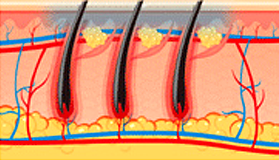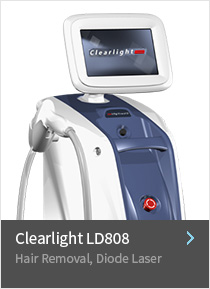Hair removal
Basic principle : Hair structure
A hair follicle is a mammalian skin organ that produces hair. Hair production occurs in phases, including growth (anagen), cessation (catagen), and rest (telogen) phases.
All hair follicles have the same basic arrangement, with epithelial progenitor cells at the base giving rise to multiple intermediary cell lineages that form the hair shaft and its guiding channel. Epithelial progenitors themselves surround a core cluster of mesenchymal cells, the dermal papilla (DP), which is thought to provide signals to coordinate hair growth.
The papilla is a large structure at the base of the hair follicle. The papilla is made up mainly of connective tissue and a capillary loop. Cell division in the papilla is either rare or non-existent.
Around the papilla is the hair matrix, a collection of epithelial cells often interspersed with the pigment-producing cells, melanocyte. Hair color is determined by the amount of pigment in the hair shaft. Melanocytes produce two types of melanin: eumelanin, a brown-black pigment; and pheomelanin, a red pigment. Melanocytes are located in the upper portion of the hair bulb and outer root sheath of the infundibulum. (Sennett et al., 2012; Ibrahimi et al., 2011)

How does it work
The efficacy of certain laser systems to destroy hair follicles within the skin is based on the theory of selective photothermolysis and its further development. This concept aims for the permanent elimination of the dermal papilla and/or the stem cells within the bulge region. Terminal hair follicles are selectively damaged if a wavelength absorbed by melanin is applied to heat the structure. Although a number of wavelengths are available and long-lasting removal of hair was observed years ago, the procedure and systems are still being improved.(Grunewald et al., 2014)

